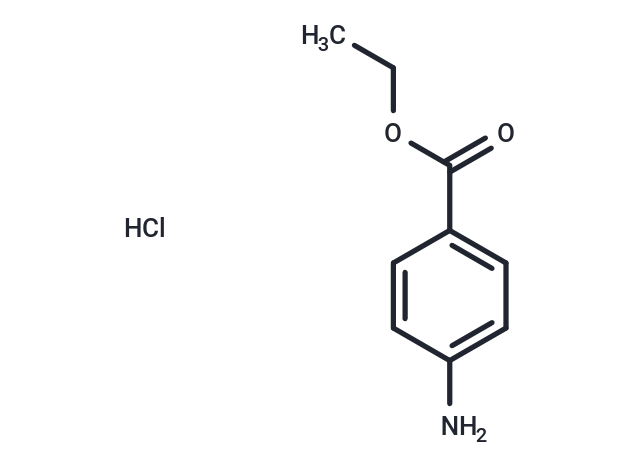Shopping Cart
- Remove All
 Your shopping cart is currently empty
Your shopping cart is currently empty

Benzocaine hydrochloride (Ethyl 4-aminobenzoate hydrochloride) is a surface anesthetic that acts by preventing transmission of impulses along nerve fibers and at nerve endings.

| Pack Size | Price | Availability | Quantity |
|---|---|---|---|
| 50 mg | $50 | Backorder | |
| 100 mg | $65 | Backorder | |
| 200 mg | $118 | Backorder | |
| 500 mg | $198 | Backorder | |
| 1 mL x 10 mM (in DMSO) | $50 | Backorder |
| Description | Benzocaine hydrochloride (Ethyl 4-aminobenzoate hydrochloride) is a surface anesthetic that acts by preventing transmission of impulses along nerve fibers and at nerve endings. |
| In vitro | AZD7762, a more selective Chk1 inhibitor, inhibits Chk1 phosphorylation of a cdc25C peptide by reversibly binding to the ATP-binding site of Chk1, with IC50 of 5 nM and Ki of 3.6 nM. AZD7762 induces cell arrest with EC50 of 0.620 μM, and significantly abrogates the camptothecin induced G2 arrest with an EC50 of 10 nM, by blocking the chk1 dependent degradation of Cdc25A and activation of Cyclin A. AZD7762 (300 nM) enhances the antitumor efficacy of gemcitabine against SW620 and topotecan against MDA-MB-231 by reducing the GI50 values from 24.1 nM and 2.25 μM to 1.08 nM and 0.15 μM, respectively. [1] AZD7762 shows cytotoxicity against a variety of neuroblastoma cell lines bearing p53 wild type, p53 mutation, Mdm2 amplification or p14 deletion with IC50 values ranging from 82.6-505.9 nM. [2] |
| Alias | Ethyl p-aminobenzoate hydrochloride, Ethyl 4-aminobenzoate hydrochloride, Benzocaine HCl |
| Molecular Weight | 201.65 |
| Formula | C9H11NO2·HCl |
| Cas No. | 23239-88-5 |
| Smiles | Cl.CCOC(=O)c1ccc(N)cc1 |
| Relative Density. | 1.31g/cm3 |
| Storage | Powder: -20°C for 3 years | In solvent: -80°C for 1 year | Shipping with blue ice. | |||||||||||||||||||||||||||||||||||
| Solubility Information | DMSO: 38 mg/mL (188.45 mM), Sonication is recommended. Ethanol: 38 mg/mL (188.45 mM), Sonication is recommended. H2O: <1 mg/mL | |||||||||||||||||||||||||||||||||||
Solution Preparation Table | ||||||||||||||||||||||||||||||||||||
DMSO/Ethanol
| ||||||||||||||||||||||||||||||||||||

Copyright © 2015-2025 TargetMol Chemicals Inc. All Rights Reserved.